Understanding What Tripe Is and Why It Matters
What is tripe? Tripe is the edible stomach lining of farm animals, most commonly cattle, sheep, goats, and pigs. This organ meat has been a staple protein source across cultures for centuries and is prized for its ability to absorb flavors like a culinary sponge.
Quick Answer for “What is Tripe”:
- Definition: Edible stomach lining from ruminant animals
- Main Types: Blanket, honeycomb, book, and reed tripe (from different stomach chambers)
- Common Sources: Cattle (most popular), sheep, goats, pigs
- Texture: Chewy when raw, tender when slow-cooked properly
- Flavor: Mild and neutral, absorbs surrounding seasonings
- Nutrition: High protein (10g per 3oz), rich in B12, selenium, zinc
As renowned chef Fergus Henderson once said, “Don’t let the word tripe deter you – let its soothing charms win you over and enjoy it as do those who always have!”
For adventurous food travelers, tripe represents the essence of nose-to-tail dining and authentic local cuisine. From Mexican menudo to Italian trippa alla romana, this sustainable protein appears in beloved comfort dishes worldwide. While it might sound intimidating, tripe is simply another path to finding the true flavors of a destination.
The recent rise in sustainable eating has brought tripe back into the spotlight. It’s an affordable, nutrient-dense option that supports zero-waste cooking practices while offering travelers genuine cultural experiences.
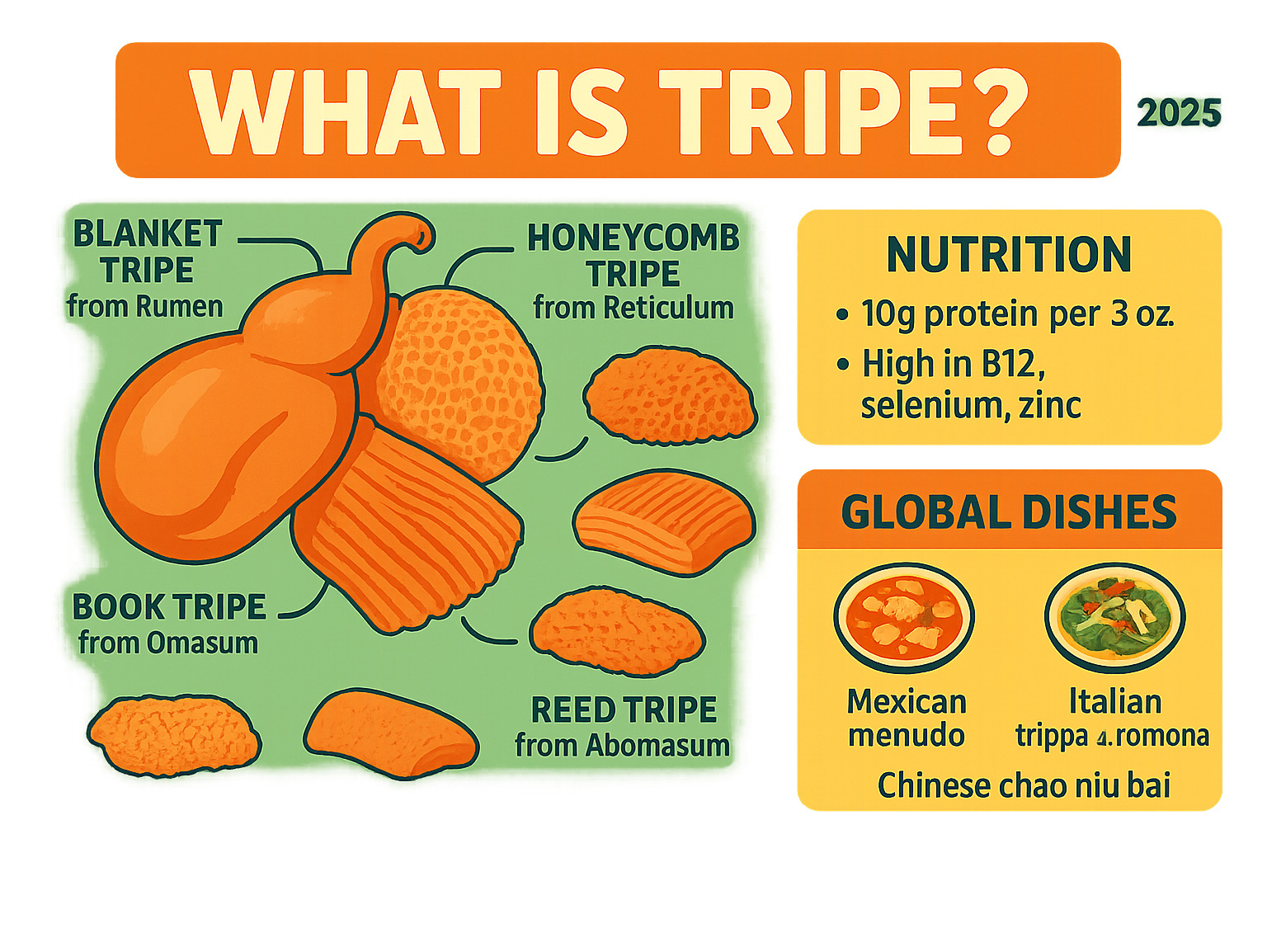
Simple what is tripe word guide:
What Is Tripe? Definition, Animals & Key Types
What is tripe becomes clearer when you understand how ruminant animals work. Cattle, sheep, and goats have fascinating four-chambered stomachs that help them digest grass and other tough plant materials. Each chamber creates a different type of tripe with its own personality and cooking style.
So, what is tripe exactly?
Tripe comes mainly from the rumen, which is the largest stomach chamber of these grass-eating animals. This edible offal has kept communities well-fed for thousands of years, turning what could be waste into hearty, nutritious meals. The story of tripe stretches back to ancient Rome and continues today in busy street food markets around the world.
Think of tripe as nature’s flavor sponge. While it starts out pretty neutral tasting, it soaks up whatever seasonings and spices you cook it with. That’s why it works so beautifully in everything from spicy Mexican soups to rich Italian stews.
The four main types of beef tripe each bring something different to the table. Blanket tripe comes from the first stomach chamber and has a smooth, flat look – some folks say it resembles a shag carpet. It’s tough and often ends up in pet food rather than on dinner plates.
Honeycomb tripe is the superstar here. From the second stomach, it gets its name from those beautiful hexagonal patterns that look just like a bee’s honeycomb. Chefs love this type because it’s more tender and grabs onto flavors better than the others. You’ll pay more for it, but it’s worth every penny.
Book tripe from the third stomach looks like layered book pages. It has a consistent texture that works great in sausages and stews where you want every bite to feel the same. Reed tripe from the fourth chamber is the rarest – it’s often used to make cheese instead of ending up in your soup bowl.
Cattle aren’t the only source, though. Sheep tripe shows up in traditional Scottish haggis, while goat tripe adds richness to Caribbean and African dishes. Pig stomach (technically called “maw”) works similarly in cooking. Some coastal areas even use fish tripe, especially from cod, in their local stews.
What is tripe called around the world?
The many names for tripe tell the story of its global journey. In Mexico and across Latin America, “menudo” means the famous tripe soup that’s perfect for weekend mornings. Spanish cooks call their tripe dishes “callos,” while Italians lovingly prepare “trippa” in countless regional ways.
Portuguese kitchens know it as “tripas,” and Filipino cooks add it to their rich “kare-kare” stew. Each name carries the weight of family traditions and generations of home cooking wisdom.
Scientific research on ruminants helps explain how these amazing digestive systems create the unique textures that make tripe such a versatile ingredient in kitchens worldwide.
Nutritional Profile & Health Insights
When it comes to what is tripe nutritionally, you might be surprised by just how much this humble organ meat brings to the table. Think of tripe as nature’s multivitamin wrapped in an affordable, sustainable package.
A modest 3-ounce serving of cooked tripe delivers an impressive 10 grams of complete protein while keeping calories remarkably low at just 80 calories. That’s less fat and fewer calories than most cuts of beef, yet you’re getting all the essential amino acids your body needs. For anyone watching their waistline while trying to build muscle, tripe offers serious bang for your nutritional buck.
The real nutritional magic happens with the micronutrients. Tripe absolutely shines when it comes to vitamin B12, providing a whopping 58% of your daily needs per 100-gram serving. This makes it a powerhouse for preventing anemia and keeping your red blood cells healthy. If you’ve been feeling tired or run-down, tripe might be exactly what your body is craving.
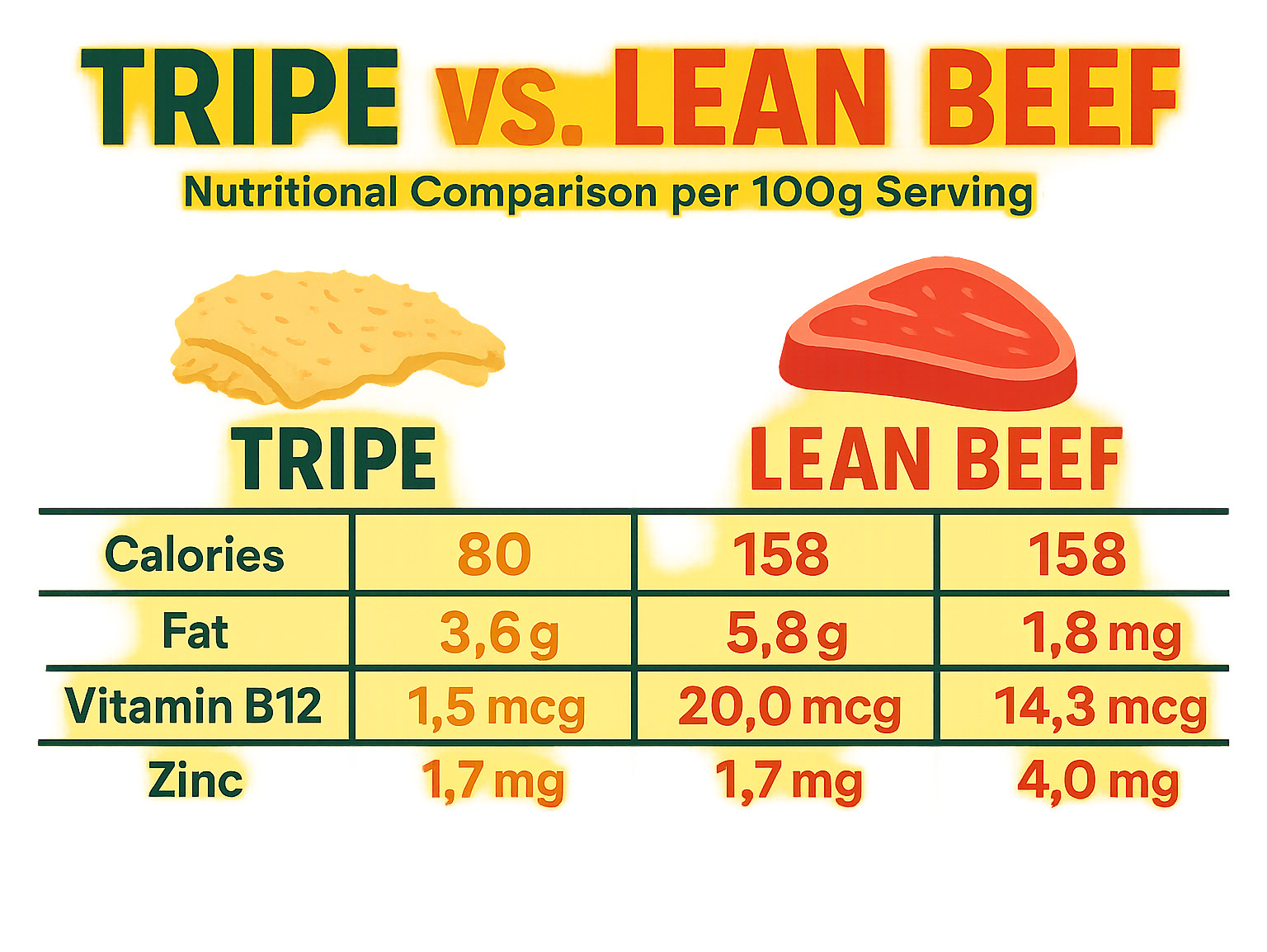
Selenium is another standout nutrient, with tripe providing about 33% of your daily value. This often-overlooked mineral works behind the scenes supporting your immune system and potentially reducing risks of heart problems and arthritis. Scientific research on selenium benefits continues to reveal just how important this mineral is for cellular protection and keeping your metabolism humming along smoothly.
The zinc content reaches 19% of daily values, while you’ll also find meaningful amounts of iron, potassium, magnesium, calcium, and phosphorus. These minerals team up to support everything from bone health to muscle building to immune function.
For weight management enthusiasts, tripe’s high protein and low calorie combination creates excellent satiety. The protein helps curb your appetite and reduces those late-night snacking urges, while the minimal 3.4 grams of fat per serving keeps your calorie budget in check.
Here’s where we need to talk honestly about the elephant in the room: cholesterol. At 133 mg per serving (about 44% of daily recommended intake), tripe does pack a cholesterol punch. If you’re monitoring your cholesterol levels, you’ll want to enjoy tripe in moderation and chat with your healthcare provider about how it fits into your overall diet.
One bonus benefit worth mentioning is tripe’s natural collagen content. While cooking breaks much of this down into gelatin, it still provides some support for joint health and skin elasticity. Think of it as a budget-friendly alternative to expensive collagen supplements.
The bottom line? Tripe offers exceptional nutrition at a fraction of the cost of premium cuts. It’s particularly valuable for anyone dealing with anemia, looking to manage weight, or simply wanting to stretch their protein budget without sacrificing nutrition.
Cleaning, Preparing & Cooking Tripe Like a Pro
The secret to mastering tripe lies in understanding that proper preparation is half the battle. Once you know the basics, this humble ingredient transforms from intimidating oddity into a versatile canvas for incredible flavors.
When shopping for tripe, you’ll encounter two main types: green tripe (uncleaned and straight from the animal) and dressed tripe (pre-cleaned and bleached). Most home cooks should stick with dressed tripe from the butcher or grocery store – it’s already been cleaned, trimmed of excess fat, boiled, and bleached to that characteristic white color.
Even dressed tripe needs attention before cooking. Start by giving it a thorough rinse under cold running water to remove any lingering chlorine residue from the bleaching process. Pat it dry and examine the surface for any remaining bits of fat or membrane that need trimming.
If you’re working with fresh, undressed tripe, the cleaning process requires more elbow grease. Remove any visible fat and interior membranes first. Then create a salt-vinegar scrub using coarse salt and white vinegar – this abrasive mixture helps remove stubborn debris and odors. Scrub thoroughly, then rinse repeatedly under running water until the tripe looks clean and smells neutral.
The cooking process is where patience pays off. Tripe’s tough connective tissues only become tender with slow, gentle cooking over 2-4 hours. Rushing this step results in chewy, unpleasant texture that turns people away from this nutritious ingredient.
Parboiling is your first step regardless of cooking method. Place the cleaned tripe in a large pot with aromatic vegetables like onion, carrot, and celery. Cover with water, bring to a boil, then simmer for 15 minutes. This removes any remaining odors and begins the tenderizing process.
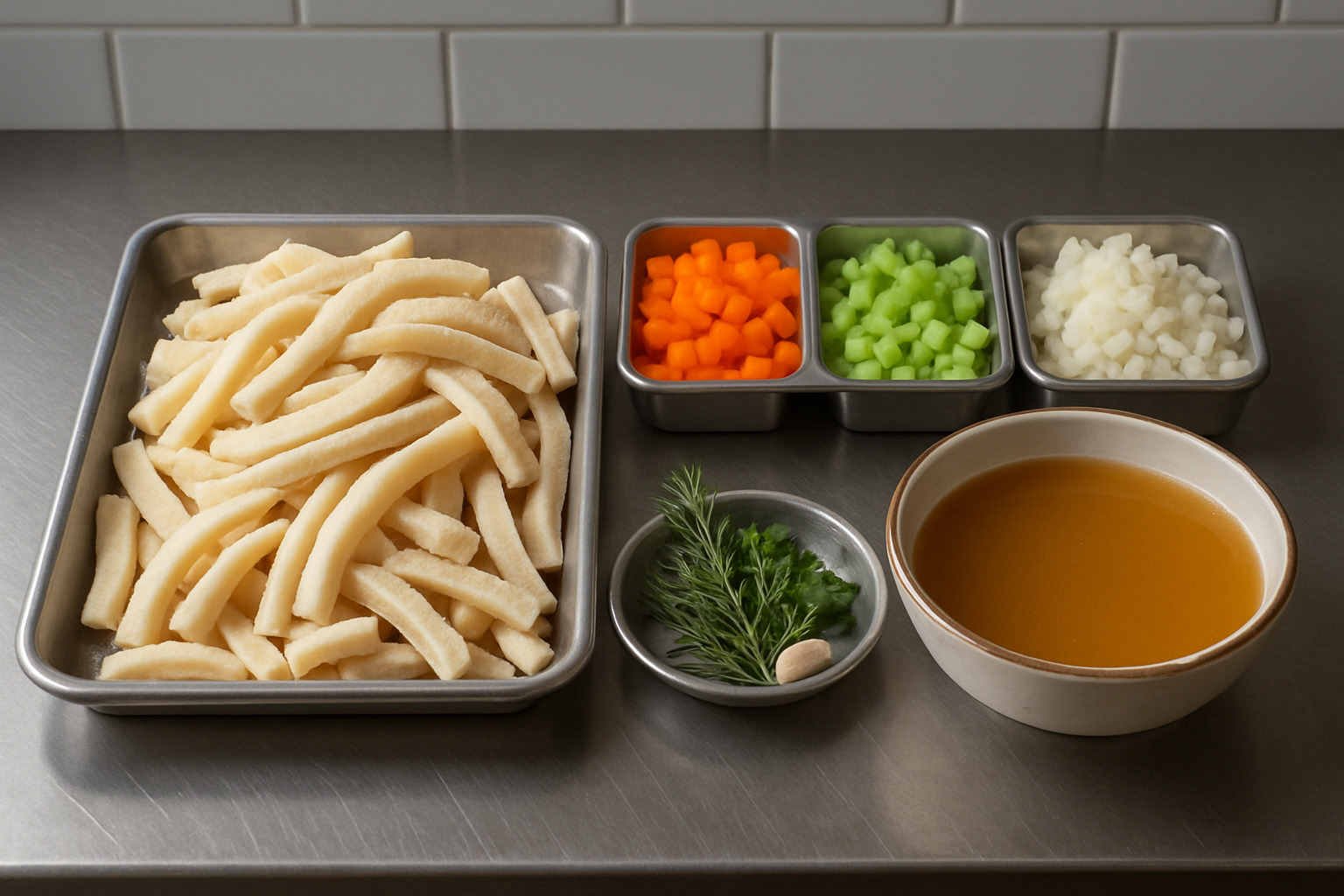
For traditional slow simmering, drain the parboiled tripe and start fresh with your cooking liquid. Whether you’re making Mexican menudo or Italian trippa, the principle remains the same – gentle bubbling in seasoned broth until fork-tender. This usually takes 2-4 hours depending on the thickness of your tripe pieces.
Modern cooks can cut cooking time dramatically using a pressure cooker. After parboiling, 45-60 minutes under pressure achieves similar tenderness. However, many traditionalists insist the slow method produces superior texture and flavor absorption.
Deep-frying and grilling work well for pre-cooked tripe that’s already tender. These methods add textural contrast and concentrated flavors that complement tripe’s mild taste.
The real magic happens with flavor pairings. Since tripe acts like a flavor sponge, bold seasonings work best. Garlic and onions form the foundation of most tripe dishes worldwide. Tomatoes add acidity that balances the rich, gelatinous texture. Chiles bring heat and complexity, while herbs like oregano, thyme, and bay leaves provide aromatic depth.
Kitchen safety deserves attention when working with organ meats. Always choose USDA-inspected tripe from reputable sources. Cook to an internal temperature of 160°F (71°C) to ensure food safety. Keep raw tripe refrigerated and use within two days of purchase.
Professional techniques make a difference in consistent results. Many restaurant kitchens employ what is a sous chef? methods for precise timing and temperature control during the long cooking process. This attention to detail separates memorable tripe dishes from disappointing ones.
What is tripe cooking is about building layers of flavor over time. Start with good ingredients, be patient with the process, and don’t be afraid to taste and adjust seasonings as you go. The reward is a deeply satisfying dish that connects you to centuries of culinary tradition.
Global Dishes & Cultural Spotlight
Across the globe, what is tripe becomes clear through the lens of beloved comfort dishes that transform this humble ingredient into culinary treasures. Each culture has finded unique ways to honor tripe’s flavor-absorbing qualities, creating dishes that often define regional identity.
In Mexico, menudo reigns supreme as the weekend warrior’s breakfast of choice. This ruby-red soup combines honeycomb tripe with hominy in a broth perfumed with dried chiles, garlic, and oregano. Families gather around steaming bowls on Saturday and Sunday mornings, sharing stories while the soup works its legendary magic against the previous night’s festivities. The preparation starts the day before, with patient simmering that transforms tough tripe into silky, tender morsels.
Rome’s trippa alla romana showcases Italian mastery of turning simple ingredients into pure comfort. The eternal city’s cooks braise tripe with San Marzano tomatoes, sweet onions, and fresh mint until the sauce clings lovingly to each piece. Served with a generous shower of pecorino Romano and crusty bread for scarpetta (literally “little shoe” – the Italian art of sopping up every last drop), this dish converts even the most skeptical diners.
Spain’s regional pride shines through callos, a hearty stew that changes personality from city to city. Madrid’s version marries tripe with chorizo, blood sausage, and chickpeas in a sauce perfumed with smoky pimentón. Head north to Asturias, and you’ll find white beans replacing chickpeas, creating an entirely different but equally satisfying experience.
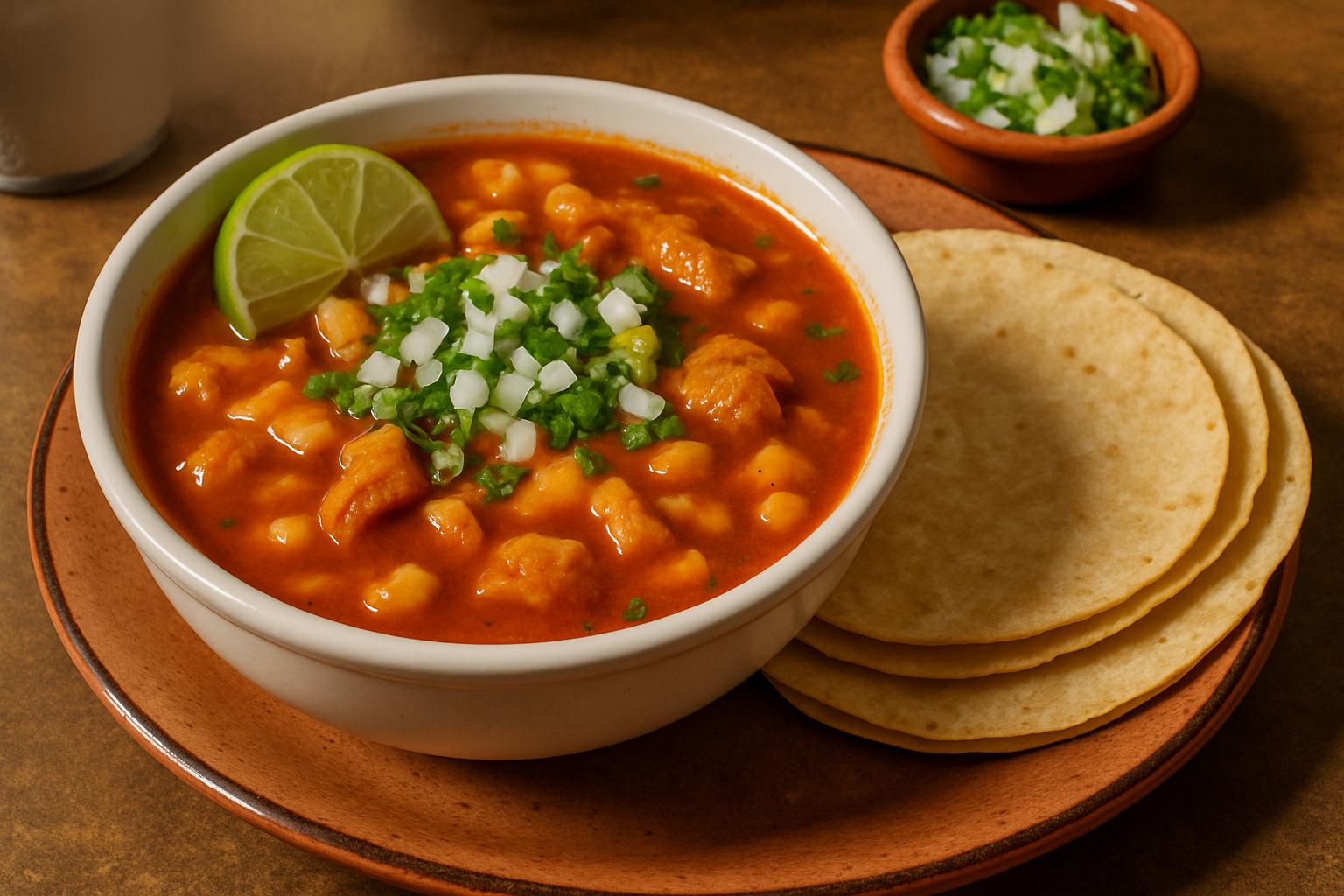
The Philippines transforms tripe into kare-kare, a golden peanut stew that pairs the organ meat with oxtail and crisp vegetables. The rich, nutty sauce gets its perfect counterpoint from bagoong (fermented shrimp paste), creating a harmony of flavors that defines Filipino comfort food.
Chinese dim sum kitchens present tripe as delicate morsels, braised with ginger and scallions until each piece offers the perfect chew alongside your morning tea. The contrast between tripe’s substantial texture and the lighter dim sum offerings creates a satisfying rhythm in the meal.
Portugal’s tripas à moda do Porto holds such cultural significance that Porto residents proudly call themselves “Tripeiros” (tripe eaters). This white bean and tripe stew, enriched with chouriço sausage, sustained the city through difficult times and remains a source of local pride.
Nigerian cooks combine tripe with other organ meats in fiery tomato stews, while Peru’s cau-cau turns vibrant yellow with cilantro and aji amarillo peppers. Greece offers patsas, a garlicky tripe soup traditionally consumed after late nights, sometimes enriched with creamy avgolemono sauce.
World Tripe Day falls on October 24th, commemorating Samuel Pepys’s 1662 diary entry praising a particularly memorable tripe dinner. This quirky food holiday encourages adventurous eaters worldwide to explore their local tripe traditions.
The persistent myth about tripe soups curing hangovers likely stems from their high protein content, B-vitamin richness, and deeply comforting nature rather than any mystical properties. Still, there’s something undeniably restorative about a steaming bowl of well-prepared tripe stew.
For food tourists seeking authentic experiences, street food tours often feature local tripe specialties, providing safe, guided introductions to dishes that might otherwise seem intimidating. These experiences offer genuine cultural immersion through the universal language of comfort food.
Buying, Storage, Safety & Sustainability
Finding quality tripe has become much easier as more people find what is tripe and accept nose-to-tail eating. Your best bet starts with local butcher shops, especially those serving diverse communities who understand the value of organ meats. These specialists often carry multiple types and can explain the differences between honeycomb, blanket, and other varieties.
Ethnic markets remain tripe treasure troves. Mexican grocers stock it for weekend menudo preparations, while Italian markets cater to trippa lovers. Asian markets often feature both fresh and frozen options, and Caribbean stores understand the importance of quality organ meats for traditional stews.
Mainstream supermarkets have started catching on too. Many now stock frozen or packaged tripe in their meat sections, though selection might be limited. Online delivery services increasingly offer tripe, though shipping costs can make it expensive for small quantities.
When shopping, always choose “dressed” tripe whenever possible. This pre-cleaned version saves hours of preparation time and reduces kitchen odors significantly. Quality tripe should smell clean and mild – never fishy or sour. The color should be consistent, whether you’re buying white bleached tripe or brownish unbleached varieties.
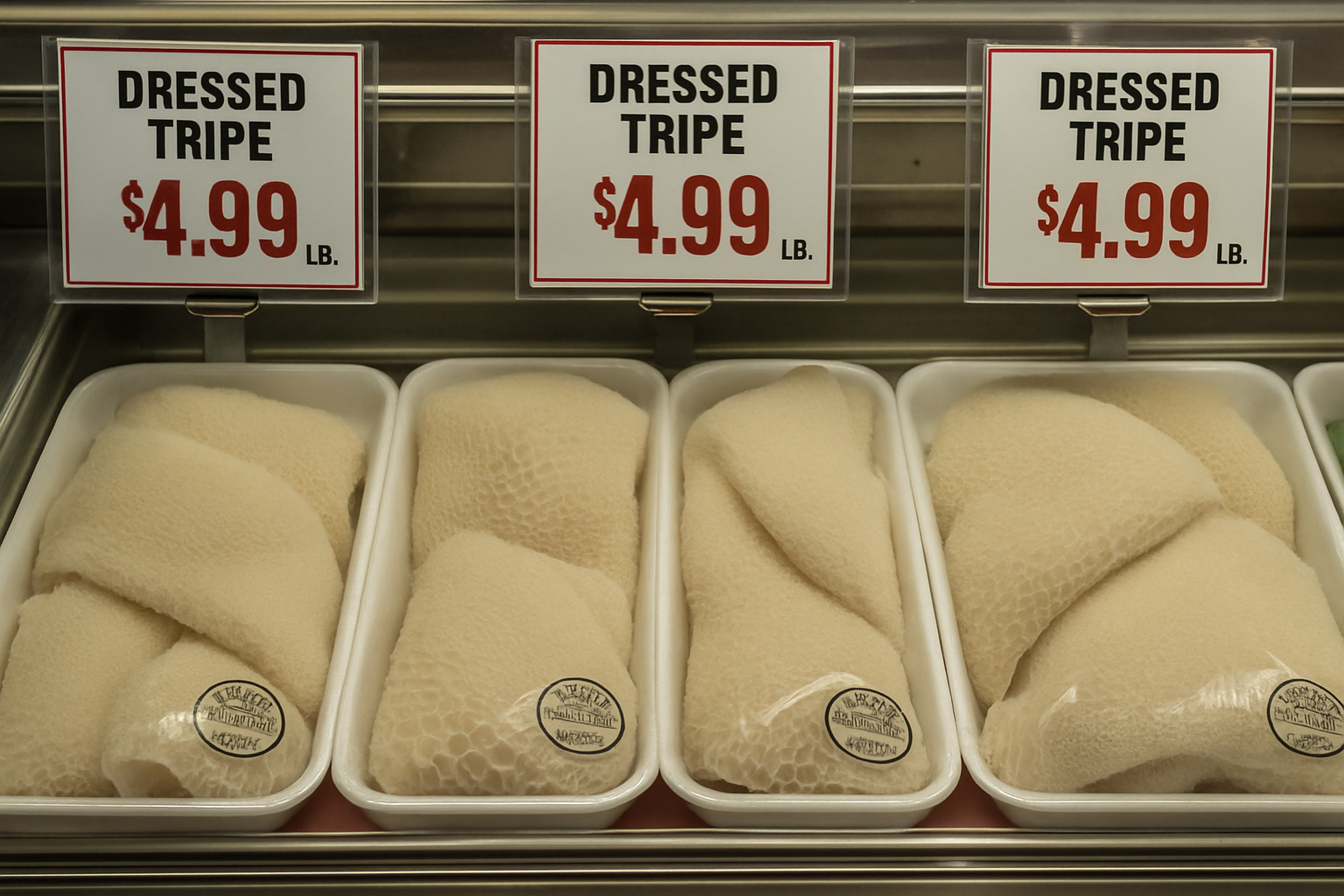
Storage requires attention to timing. Fresh tripe needs immediate refrigeration and should be used within 2 days maximum. For longer storage, wrap it tightly and freeze for up to 3 months. Always thaw frozen tripe safely in the refrigerator – never at room temperature where bacteria can multiply.
Here’s a pleasant surprise: cooked tripe dishes often taste better the next day as flavors meld together. Refrigerated leftovers stay good for 3-4 days, making tripe perfect for meal prep.
Safety stays straightforward with proper handling. Purchase only USDA-inspected tripe from reputable sources. Remove any remaining internal membranes or fat before cooking. Cook to internal temperatures of 160°F (71°C) for complete food safety. Always wash hands and surfaces thoroughly after handling raw tripe.
The sustainability story makes tripe even more appealing. When we eat organ meats, we honor the entire animal and dramatically reduce food waste. This supports regenerative grazing practices where grass-fed ruminants actually help carbon sequestration in soil through their natural grazing patterns.
Budget-friendly protein doesn’t begin to describe tripe’s economic advantages. It costs a fraction of premium cuts while delivering superior nutrition per dollar. This makes it perfect for stretching food budgets without sacrificing nutritional quality.
Supporting nose-to-tail eating encourages farmers and butchers to value every part of the animal. This can improve animal welfare standards and reduce waste throughout the entire supply chain. Many traditional cultures developed beloved tripe dishes from necessity, creating delicious meals from ingredients that might otherwise be discarded.
The growing interest in sustainable dining aligns perfectly with tripe’s environmental benefits. Just like chicharrones, tripe represents how proper preparation and cultural appreciation can transform less expensive ingredients into cherished dishes.
Frequently Asked Questions about Tripe
How long should I cook tripe to make it tender?
The secret to tender tripe lies in patience and gentle heat. What is tripe without proper cooking? Simply put, it’s a tough, chewy disappointment that scares people away from this wonderful ingredient.
Plan for 2-4 hours of slow simmering using traditional stovetop methods. The key word here is “slow” – high heat will turn your tripe into rubber bands that even your dog might reject. Think of it like a meditation practice for your kitchen.
If you’re in a hurry, a pressure cooker reduces cooking time to 45-60 minutes. This modern approach works beautifully, though some traditionalists swear the slow method develops better flavor.
Start with a 15-minute parboil to eliminate any lingering odors. Your neighbors will thank you for this step. Then begin the main cooking process with your chosen seasonings and aromatics.
Test for doneness by piercing with a sharp knife – properly cooked tripe should yield easily without falling apart. Here’s a pro tip: tripe often tastes even better the next day as flavors continue developing, so don’t worry if your first bite seems a bit bland.
Is tripe safe to eat if I watch my cholesterol?
This question comes up frequently, and the answer requires some nuance. Tripe contains approximately 133 mg of cholesterol per 3-ounce serving, which represents about 44% of the daily recommended intake. That’s definitely not insignificant.
However, the complete nutritional picture tells a more complex story. You’re getting high-quality protein, minimal calories, and exceptional micronutrient content – particularly vitamin B12 and selenium. It’s like getting premium nutrition in a budget-friendly package.
The reality is that people respond differently to dietary cholesterol. Some folks are “cholesterol hyper-responders” who need to watch every milligram, while others can enjoy moderate amounts without seeing significant changes in their blood cholesterol levels.
Consult your healthcare provider about incorporating tripe into your specific dietary plan. They know your health history and can provide personalized guidance that generic advice simply can’t match.
Interestingly, the selenium and other antioxidants in tripe may actually provide cardiovascular benefits, but individual responses vary significantly.
Can I substitute other cuts if I can’t find tripe?
Ah, the eternal question of culinary substitution! While nothing perfectly replicates tripe’s unique texture and flavor-absorbing superpowers, several alternatives can work depending on your specific dish.
For texture similarity, try thinly sliced king oyster mushrooms, which offer a surprisingly similar chewiness. Firm tofu works in Asian preparations, while calamari rings provide comparable bite in Mediterranean dishes. These won’t give you the same nutritional profile, but they’ll satisfy the textural craving.
When you need something that absorbs flavors in long-braised stews, consider tougher cuts like chuck roast or short ribs. While the texture differs completely, these cuts also benefit from slow cooking and develop rich, complex flavors through extended braising.
In Asian preparations, some creative cooks substitute fish maw or dried bean curd sheets for similar textural interest. These ingredients bring their own unique qualities to the dish.
But here’s the honest truth: part of tripe’s appeal lies in its complete uniqueness. The way it transforms through cooking and becomes a flavor sponge remains distinctive among ingredients. Sometimes the best substitute is simply embracing the trip and tracking down real tripe for the authentic experience.
Conclusion & Your Next Culinary Trip
Understanding what is tripe opens doors to authentic culinary experiences that most travelers never find. This humble ingredient connects us to food traditions spanning centuries, from busy street vendors serving steaming menudo to family-run trattorias perfecting their trippa alla romana recipes.
For adventurous food lovers, tripe represents everything exciting about culinary exploration. Its neutral flavor profile becomes a canvas for global seasonings, while its impressive nutritional benefits support healthy eating goals without breaking the budget. What is tripe if not the perfect example of how sustainable eating can be both delicious and culturally enriching?
The nose-to-tail dining movement continues gaining momentum, especially in food-forward cities like New York City where innovative chefs celebrate whole-animal cooking. This shift toward sustainable dining practices makes ingredients like tripe increasingly relevant for environmentally conscious diners who want to reduce food waste while exploring authentic flavors.
Starting your tripe journey doesn’t require diving into the deep end. Begin by visiting well-regarded restaurants known for traditional preparations. Many dishes that initially seem intimidating become surprising favorites once you experience them prepared by skilled hands. The key lies in approaching unfamiliar ingredients with curiosity rather than prejudice.
The protein-on-a-budget aspect makes tripe particularly appealing for food travelers who want to maximize their culinary experiences without overspending. Its ability to absorb surrounding flavors means every culture has developed unique preparations that reflect local tastes and available ingredients.
As regenerative grazing and carbon sequestration become more important in sustainable food systems, supporting restaurants that practice whole-animal utilization helps create positive change. Every bowl of tripe stew represents a small victory against food waste and a celebration of cultural preservation.
Your next culinary trip might begin with a simple question at a local market or restaurant. The courage to try something new often leads to the most memorable food experiences. After all, today’s exotic ingredient frequently becomes tomorrow’s comfort food.
For more inspiration on finding authentic local cuisines around the world, explore our comprehensive guide to best food destinations where traditional tripe dishes feature prominently in street food scenes and family restaurants.
The Dining Destination believes that food tourism thrives when we accept the full spectrum of global cuisine. Sometimes the most rewarding culinary findies come from the most unexpected places.

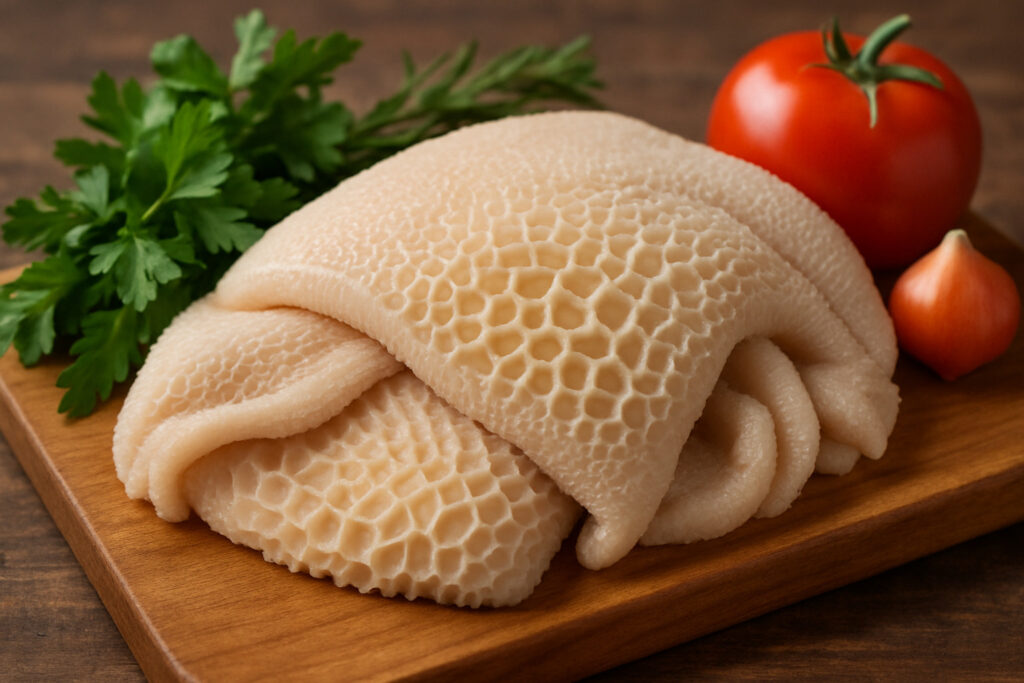






1 thought on “All About Tripe: What It Is and How It’s Used”
Pingback: All About Chorizo: Types, Origins, and How to Use It - The Dining Destination
Comments are closed.